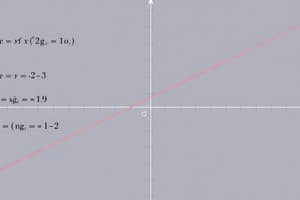Podcast
Questions and Answers
What is the primary condition required for selecting an interval [a, b] to initiate the Bisection method for solving the equation $x^3 + x^2 - 1 = 0$?
What is the primary condition required for selecting an interval [a, b] to initiate the Bisection method for solving the equation $x^3 + x^2 - 1 = 0$?
- The function $f(x)$ must be negative at both 'a' and 'b'.
- The values of 'a' and 'b' must be integers.
- The function $f(x)$ must have opposite signs at 'a' and 'b'. (correct)
- The function $f(x)$ must be positive at both 'a' and 'b'.
Given an interval [0, 1] for the equation $f(x) = x^3 + x^2 - 1 = 0$, what is the value of 'c' in the first bisection step?
Given an interval [0, 1] for the equation $f(x) = x^3 + x^2 - 1 = 0$, what is the value of 'c' in the first bisection step?
- 0.75
- 1.0
- 0.5 (correct)
- 0.25
If, during the Bisection method, $f(a)$ is negative and $f(c)$ is also negative, what should be the new interval for the next iteration?
If, during the Bisection method, $f(a)$ is negative and $f(c)$ is also negative, what should be the new interval for the next iteration?
- The new interval should be [c, b] (correct)
- The new interval should be [a, b] still.
- The method should terminate as a root has been found
- The new interval should be [a, c]
When using Bisection method to achieve root using 4 decimal place accuracy, what is the tolerance (maximum error) that must be reached?
When using Bisection method to achieve root using 4 decimal place accuracy, what is the tolerance (maximum error) that must be reached?
After several iterations of the bisection method, the interval has narrowed to [1.1795,1.1799]. What is the most accurate approximation of the root at this point.
After several iterations of the bisection method, the interval has narrowed to [1.1795,1.1799]. What is the most accurate approximation of the root at this point.
Flashcards
Bisection Method
Bisection Method
A numerical method for finding the root of an equation by repeatedly dividing the interval where the root lies in half.
Root of an Equation
Root of an Equation
The point where a function crosses the x-axis, also known as the root or solution of the equation.
Accuracy of 4 Decimal Places
Accuracy of 4 Decimal Places
The desired level of accuracy for the root. In this case, the result should be accurate to 4 decimal places.
Interval Reduction
Interval Reduction
Signup and view all the flashcards
Function Sign Change
Function Sign Change
Signup and view all the flashcards
Study Notes
Bisection Method for Solving x³ + x² - 1 = 0
-
The bisection method is an iterative numerical method for finding the approximate root of a continuous function.
-
The method relies on repeatedly narrowing down an interval where a root is guaranteed to exist.
-
To apply the bisection method, we first need to identify an interval [a, b] where f(a) and f(b) have opposite signs. This guarantees a root exists within the interval by the Intermediate Value Theorem.
-
For the equation x³ + x² - 1 = 0, let f(x) = x³ + x² - 1.
-
We need to find an interval [a, b] such that f(a) and f(b) have opposite signs.
-
Trying different values of x:
- f(0) = -1
- f(1) = 1
- f(0.5) = -0.375 < 0 and f(1) = 1 >0, so a = 0.5 and b = 1 is a valid interval.
-
The iterative steps involve:
- Calculating the midpoint c = (a + b) / 2
- Evaluating f(c)
- If f(c) = 0, then c is the root.
- If f(c) has the same sign as f(a), then update a = c
- If f(c) has the same sign as f(b), then update b = c.
-
Repeat these steps until the width of the interval [a, b] is sufficiently small, typically to meet a desired tolerance or number of iterations.
-
Example of Iterations using initial interval [0.5, 1]
- Iteration 1: c = (0.5 + 1) / 2 = 0.75. f(0.75) = 0.75³ + 0.75² - 1 = 0.421875 + 0.5625 -1 = -0.015625. Since f(0.75) < 0, update a = 0.75.
- Iteration 2: c =(0.75 + 1) / 2 = 0.875. f(0.875) = 0.66201 + 0.765625 - 1 = .0.42765 < 0 . Update a to 0.875.
- Iteration 3: c = (0.875 + 1 ) / 2 = 0.9375. f(0.9375) = 0.830078125 + 0.87890625 - 1 = 0.708984375 > 0 . Update the interval of b=0.9375.
- Iteration 4: c = (0.875 + 0.9375 ) / 2 = 0.90625 f(0.90625 ) > 0. So the interval is updated.
-
After multiple iterations, the interval [a, b] will converge to the root. Continued iterations, which are best done using a computer or a program.
-
By systematically applying the iterative process, the method will converge to a solution for x, and successive midpoint values of c get progressively closer to the precise root.
-
Obtaining the solution to four decimal places requires repeating the steps until the interval width (b - a) is sufficiently small.
-
The calculated root to four decimal places should be the value that falls between the a and b values.
Determining the accuracy
- The method's accuracy is established by the width of the interval.
- Iterate until the difference between successive approximations is less than the desired error tolerance (typically expressed as |b - a| < 0.0001 in this case).
- If the difference between any two consecutive c values is small enough (less than 0.0001), the solution is accurate to four decimal places and should be used.
Studying That Suits You
Use AI to generate personalized quizzes and flashcards to suit your learning preferences.




